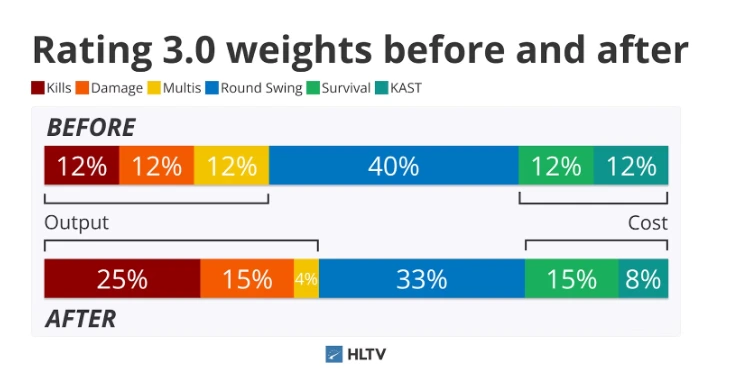In the competitive shooting game scene, changes to data evaluation systems often signify a shift in the landscape. HLTV’s Rating 3.0 significantly adjusts how it measures player performance: from now on, “Kills” receive a higher weight, while the previously controversial “Round Swing” metric has been weakened. Meanwhile, CS2’s ranking system (including the traditional Competitive ranking and the newly introduced Premier rating system) is increasingly becoming a focus of player attention. This article will delve into these two major changes, exploring the underlying logic, player and team reactions, and potential future impacts.
Rating 3.0: Why? What are the changes?
HLTV released the initial description of Rating 3.0 in August 2025, stating that this is the biggest rating system change since 2017. The main changes are as follows:
Introduction of Round Swing: A new metric that measures the change in the team’s probability of winning the round before and after each kill.
All sub-ratings (Kills, Damage, Survival, KAST, Multi-Kills, Round Swing) are adjusted based on economic conditions: for example, killing an opponent who only uses Glock will have its value reduced.
On October 29, 2025, HLTV released a hotfix version that increased the weight of “kills,” reduced the weight of Round Swing, and improved several data logics.
This fix also unified previous match data to the latest version, and the previously selected EVPs (Best Performers) and the annual Top 20 list will be re-evaluated.

Reasons for the Change
The original intention of the scoring system was to be more “situation-dependent”: for example, a player’s kill in a round when they were at an economic disadvantage, or securing a Clutch in a disadvantageous situation, should be more valuable than simply having a large number of kills. Round Swing was born from this logic. However, several problems arose in practice: for example, some players had a low number of kills, but their scores were higher due to a single big Clutch or a large number of multi-kills. As a result, the scores deviated from the intuitive perception of “who is stronger.” Therefore, this revision returns to the “kills are more important” direction.
Rating 3.0 System: Competitive and Premier Dual-Track System
Meanwhile, explanations of the CS2 ranked system have become a hot topic.
Competitive Mode
Uses 18 ranks similar to Counter-Strike: Global Offensive: from Silver 1 to Global Elite.
Unlike before: each map has an independent hidden MMR, and a player’s rank on one map does not directly affect their rank on another map.
Premier Mode
Introduces a numerical rating system: Players earn an initial CS Rating after 10 wins, ranging from approximately 1,000 to 30,000+.
Different score ranges correspond to different color tiers:
Gray 0–4,999 points
Light Blue 5,000–9,999 points
Blue 10,000–14,999 points
Purple 15,000–19,999 points
Pink 20,000–24,999 points
Red 25,000–29,999 points
Gold 30,000+ points represents top players.
This mode places greater emphasis on factors such as the rating difference between the two teams, win/loss streaks, and team composition.
Relationship Between the Two and Tips for Players
While Competitive rank remains a classic symbol for players, Premier CS Rating has become a new indicator of overall skill level.
Players aiming for a “fast climb” should focus on: kills, assists, rounds won, teaming with high-rated teammates, and choosing maps they excel at.
The community has also pointed out that Premier matchmaking can sometimes be quite unpredictable: a player with a rating of 10,000 might face an opponent with a rating of 17,000.
Impact on Professional and Regular Players of Rating 3.0
Professional Level
Team player statistics will be more in-depth: kills, assists, damage share, and performance in the economy will all be included in the evaluation.
Command-oriented and support-oriented players who perform well but have low kill counts, and who cannot excel in damage or KAST (survival/assists/kills/substitutes), may be “ranked lower” by the new system.
The annual Top 20 and MVP/EVP selections will now be re-evaluated based on the new data system, meaning the “inertia advantage” of historical data may be broken.
For Regular players
The player leaderboard’s entry requirements will be more transparent and stringent: reaching the Gold rank (30,000+ kills) requires top-tier skill.
If you value kill counts, winning rounds, and economic advantages, this adjustment is more favorable. Conversely, if you prefer “tactical support” or “control-oriented” playstyles, you’ll need to prove yourself in other data areas.
Suggested path to ranking improvement: Specialize in one or two maps, allocate practice time wisely, enhance your replay analysis awareness, and pay attention to economic rounds and trading techniques.
Conclusion:
This dual overhaul of HLTV’s Rating 3.0 hotfix and the CS2 ranking system marks a new stage in competitive data analysis. Kills are now given greater value, while the contextual “round transition” effect, though weakened, still retains its influence—the key lies in how to quantify it in actual gameplay. For professional players and team analysts, understanding these details and adjusting training strategies will be crucial for future competitiveness. For the general player base, this also means that simply “grinding” is no longer sufficient; comprehensive improvement in areas such as economy, teamwork, and map proficiency is essential.
In the future, we may see two major trends:
Teams and analysts will release more data on “kills from economic disadvantage,” “trade kills,” and “round transition contribution” to more precisely assess player value.
The general player community will pay close attention to “which data directly improves my CS rating,” such as kill/round ratio, win percentage, and the chance of winning in economically disadvantaged rounds.
If you’re a dedicated CS2 player, start recording your kills, winning rounds, and performance in rounds where you’re at an economic disadvantage today. These metrics are the dividing line between future “top players” and “average players.” Are you ready to seize the opportunity in this wave of change? Feel free to share your experiences in the comments section and see which statistic you improve the fastest.

